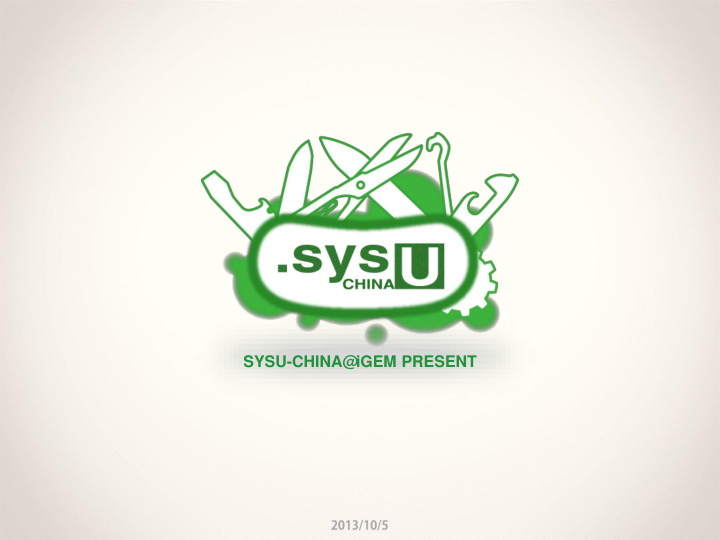



SYSU-CHINA@iGEM PRESENT
iPSCs SafeGuard F ang Yiming Z hao Yuchen L in Kaixuan C hen Haoqi S un Mengyi
Never Return Back? 3
A Revolution in View 4
Promising Prospect in Medical Application 5
(http://www2.estrellamountain.edu/) Stem Cell Technology 6
In Yamanaka’s experiment in 2009, the tumor formation rate is 30% among 100 mice transplanted with iPS cells, much higher than norman ES cells. That’s due to: Reactivation of transcription factor c-Myc, also an oncogene Wrong insertion of viral vectors 7
Trying to Optimize The Methods Optimizing viral vectors Still have risk of carcinogenesis Use non-vector methods Induction rate is even lower that can’t be put into use 8
(http://www2.estrellamountain.edu/) To Choose A Model 9
Our Model ---- Liver Cell • ( W. Ray Kim et al, Gastroenterology, 2009 ) 10
iPS Safeguard 11
Now let me show you how we design it. 12
To Liver or Not to Live! DESIGN IGN 13
iPSC Safeguard miRNA Target Suicide Gene Lentivirus Tet-off System DESIGN IGN 14
Lentivirus Target Suicide Gene Tet-off DESIGN IGN 15
Gene Parts miRNA Target Suicide Gene Tet-off System DESIGN IGN 16
Lentivirus Target Suicide Gene Tet-off miRNA-122 DESIGN IGN 17
Lentivirus Target Suicide Gene Tet-off Mechanism of miRNA-122 DESIGN IGN 18
Lentivirus Target Suicide Gene Tet-off Liver Specific DESIGN IGN 19
Lentivirus Target Suicide Gene Tet-off Suicide Gene Promoter Suicide gene miRNA-122 target DESIGN IGN 20
Lentivirus Target Suicide Gene Tet-off Suicide Gene rip1 rip3 Caspase family hBax apoptin DESIGN IGN 21
Lentivirus Target Suicide Gene Tet-off Tet-off System miRNA-122 target Promoter Suicide gene DESIGN IGN 22
Lentivirus Target Suicide Gene Tet-off miRNA-122 Liver cells iPS cells Cancer cells miRNA-122 in Different Cells DESIGN IGN 23
Lentivirus Target Suicide Gene Tet-off ON OFF Switch: Tet-off system DESIGN IGN 24
Lentivirus Target Suicide Gene Tet-off A Global View DESIGN IGN 25
Lentivirus Target Suicide Gene Tet-off DESIGN IGN 26
Lentivirus Target Suicide Gene Tet-off P ef-1 α tTA tTA DOX tTA miRNA-122 target P mincm v Suicide gene TRE DESIGN IGN 27
Now let me show you the results in 4 parts: Target Suicide Gene Tet-off Lentivirus 28
Strategy Screen Test for the best Safety& compatibility Assembly Results ts 29
Searching for the miRNA-122 Target miRNA-122 Results ts 30
miR-122 Target Responds Accordingly with miRNA-122 Level p miRNA-122/ng 0 25 50 100 250 GFP-target /ng 750 750 750 750 750 Expression level 1.00 miR-122 0.75 0.50 GFP 0.25 GAPDH 0.00 p miRNA-122/ng 0 25 50 100 250 Results ts 31
Corresponding Level of miRNA-122 15.00 Hepatocytes HEK293 12.00 1200 9.00 800 6.00 400 3.00 0 0.00 0 25 50 100 250 500 0ug 0.025ug 0.05ug 0.1ug 0.25ug 0.5ug — — 0.25ug 1ug p miRNA-122/ng P miRNA-122 Results ts 32
The Suicide Gene Results ts 33
GFP RIP 1 RIP3 HEK293 (BL) 100 μ m 100 μ m 100 μ m HepG2 (BL) 100 μ m 100 μ m 100 μ m RIP1 and RIP3 successfully induce cell death HepG2 (DAPI) Results ts 34
ApoptinSuccessfully Induces Cell Death Bright Light 100 μ m 100 μ m 488nm 48h 0h Apoptin-GFP induced cell death Results ts 35
Profile of the Suicide Genes iPSC Survival Rate (%) HepG2 Cell Survival Rate (%) 75 100 75 50 50 25 25 0 0 Mock Rip1 Rip3 Apoptin GFP Mock Rip1 Rip3 Apoptin Results ts 36
Tet-off System Results ts 37
Leaky Expression of Different TRE Results ts 38
Switching Performance of P TIGHT ON OFF Results ts 39
Test in Mouse iPSCs iPSC suvival rate (%) iPSC survival rate (%) 80 100 60 75 40 50 25 20 0 0 Mock TRE RE3G - rip ip1 TRE RE3G - rip ip3 TRE RE3G - GFP Mock Mock+Dox Results ts 40
Everybody Comes Together! Suicide Gene Lentivirus Target Tet-off Results ts 41
Lentivirus Packaging Results ts 42
Functional tests in different cell lines HepG2 stable cell line HepG 2 HEK293 Hela Day 2 Day 0 U2OS HTC75 Day 3 Day 7 Results ts 43
Now let me show you the Tuning and Modeling works 44
miRNA-122 Fine-tune the variation range of knockdown efficiency Modeling ing 45
Knockdown effect of different targets Knockdown Efficiency 0.85 0.8 0.75 0.7 2*com 2*com+2*CUTL 4*com Target Type Modeling ing 46
Interpolation Method Modulation of MiR122-Target device Modeling ing 47
Multiple-Compartment Model d 1=- k1 1 X X dt d 2 =k1 1 k2 X 2 X X dt d 3 =k2 X X 2 dt X 1 ,X 2 ,X 3 k 1 ,k 2 ,k 3 d 1=- k1 1 X X dt d 2 =n1k1 1 k2 X X X 2 dt d 3 =n2k2 X 2 X dt Modeling ing 48
Sum up Modeling ing 49
Now let me show you our future work 50
Achivements Sucide genes miRNA-122 Tet-off Futu ture e Work 51
To be Continue …… Apoptosis-related gene Do the experiments in stable cell lines Complete circuit in human iPS cells Futu ture e Work 52
Extension (Thomas M. Schmitt et al,Hum Gene Ther.2009) Futu ture e Work 53
Human Practice Futu ture e Work 54
Acknowlegement Colleage Sponsor Instructors Advisor Futu ture e Work 55
Thank you all!!! Futu ture e Work 56
Experiments on iPSCs hiPSC on feeder hiPSC on matrigel iPSC Survival Rate(%) 80 66.7 70 60 50 40 30 20 9.43 8.39 6.42 10 0 Mock rip1 rip3 apoptin Results ts 57
Mouse Primary Hepatocytes 14 Hepatocytes HEK293 12 11.29 10 8.22 8 7.02 6 4 2 1.00 pMiR-122 0 — — 0.25ug 1ug Results ts 58
Recommend
More recommend